From Siliciclastic to Bioclastic Deposits in the Gulf of Naples: New Highlights from Offshore Ischia and Procida–Pozzuoli Based on Sedimentological and Seismo-Stratigraphic Data
Abstract
:1. Introduction
2. Geologic and Oceanographic Setting
3. Materials and Methods
4. Results
4.1. Sedimentological Data
- Facies 1—Sands and Gravelly Sands
- Facies 2—Silty Sands
- Facies 3—Sandy Silts and Silts
4.2. Seismo-Stratigraphic Data
5. Discussion
6. Conclusions
Author Contributions
Funding
Institutional Review Board Statement
Informed Consent Statement
Data Availability Statement
Conflicts of Interest
References
- Riosmena-Rodriguez, R.; Nelson, W.; Aguirre, J. Rhodolith/Maerl Beds: A Global Perspective, 1st ed.; Springer: Cham, Switzerland, 2017. [Google Scholar]
- Marrack, E.C. The Relationship between Water Motion and Living Rhodolith Beds in the Southwestern Gulf of California, Mexico. Palaios 1999, 14, 159–171. [Google Scholar] [CrossRef]
- Steller, D.L.; Riosmena-Rodriguez, R.; Foster, M.S.; Roberts, C.A. Rhodolith bed diversity in the Gulf of California: The importance of rhodolite structure and consequences of disturbance. Aquat. Conserv. Mar. Freshw. Ecosyst. 2003, 13, S5–S20. [Google Scholar] [CrossRef]
- Basso, D.; Babbini, L.; Kaleb, S.; Bracchi, V.A.; Falace, A. Monitoring deep Mediterranean rhodolith beds. Aquat. Conserv. Mar. Freshw. Ecosyst. 2016, 26, 549–561. [Google Scholar] [CrossRef] [Green Version]
- Bracchi, V.A.; Basso, D. The contribution of calcareous algae to the biogenic carbonates of the continental shelf: Pontine Islands, Tyrrhenian Sea, Italy. Geodiversitas 2012, 34, 61–76. [Google Scholar] [CrossRef]
- Carannante, G.; Esteban, M.; Milliman, J.D.; Simone, L. Carbonate lithofacies as a paleolatitude indicators: Problems and limitations. Sedim. Geol. 1988, 60, 333–346. [Google Scholar] [CrossRef]
- Simone, L.; Carannante, G. The fate of foramol (“temperate-type”) carbonate platforms. Sedim. Geol. 1988, 60, 347–354. [Google Scholar] [CrossRef]
- Bourrouilh-Le Jan, F.G.; Hottinger, L.C. Occurrence of rhodolites in the tropical Pacific—A consequence of Mid-Miocene palaeo-oceanographic change. Sedim. Geol. 1988, 60, 355–367. [Google Scholar] [CrossRef]
- Pomar, L. Types of carbonate platforms: A genetic approach. Basin Res. 2001, 13, 313–334. [Google Scholar] [CrossRef]
- Basso, D.; Morbioli, C.; Corselli, C. Rhodolith facies evolution and burial as a response to Holocene transgression at the Pontiane Islands shelf break. In Cool-Water Carbonates: Depositional Systems and Palaeoenvironmental Control; Pedley, H.M., Carannante, G., Eds.; The Geological Society of London: London, UK, 2006; pp. 23–34. [Google Scholar]
- Pomar, L.; Baceta, J.I.; Hallock, P.; Mateu-Vicens, G.; Basso, D. Reef building and carbonate production modes in the west-central Tethys during the Cenozoic. Mar. Petrol. Geol. 2017, 83, 261–304. [Google Scholar] [CrossRef]
- Aguirre, J.; Braga, J.C.; Bassi, D. Rhodolits and rhodolith beds in the rock record. In Rhodolith/Maerl Beds: A Global Perspective; Riosmena-Rodriguez, R., Nelson, W., Aguirre, J., Eds.; Springer: Cham, Switzerland, 2017; pp. 105–138. [Google Scholar]
- Brandano, M.; Cornacchia, I.; Tomassetti, L. Global versus regional influence on the carbonate factories of Oligo-Miocene carbonate platforms in the Mediterranean area. Mar. Petrol. Geol. 2017, 87, 188–202. [Google Scholar] [CrossRef]
- Toscano, F.; Vigliotti, M.; Simone, L. Variety of coralline algal deposits (Rhodalgal facies) from the Bays of Naples and Pozzuoli (Northern Tyrrhenian Sea, Italy). In Cool-Water Carbonates: Depositional Systems and Palaeoenvironmental Controls; Pedley, H.M., Carannante, G., Eds.; The Geological Society of London: London, UK, 2006; pp. 85–94. [Google Scholar]
- Rendina, F.; Kaleb, S.; Caragnano, A.; Ferrigno, F.; Appolloni, L.; Donnarumma, L.; Russo, G.F.; Sandulli, R.; Roviello, V.; Falace, A. Distribution and characterization of deep rhodolith beds of the Campania coast (SW Italy, Mediterranean Sea). Plants 2020, 9, 985. [Google Scholar] [CrossRef] [PubMed]
- Funk, G. Die algenvegetation des Golfs von Neapel. Publ. Stazione Zool. Napoli. 1927, 7, 1–507. [Google Scholar]
- Funk, G. Beiträge zür kenntnis der meeresalgen von Neapel. Publ. Stazione Zool. Napoli. 1955, 25, 1–178. [Google Scholar]
- Bacci, G. Ricerche sulle zoocenosi bentoniche del Golfo di Napoli, I—La Secca di Penta Palummo. Publ. Stazione Zool. Napoli. 1947, 20, 158–178. [Google Scholar]
- Lewalle, J. Détermination macroscopique des algues rouges calcaires (Corallinaceae et Squamarciacae partim) du Golfe de Naples. Publ. Stazione Zool. Napoli. 1961, 32, 241–271. [Google Scholar]
- Segre, A.G. Geologic Map of Italy, Geological Sheet “Napoli—Isola d’Ischia”; National Geological Survey of Italy: Rome, Italy, 1967. [Google Scholar]
- Segre, A.G. La Carta batimetrica n, 1256 I.I. del Golfo di Pozzuoli; Istituto Idrografico della Marina: Genova, Italy, 1972; Volume 1053, pp. 1–12. [Google Scholar]
- Orsi, G.; Gallo, G.; Zanchi, A. Simple-shearing resurgence in caldera depressions: A model from Pantelleria and Ischia. J. Volcanol. Geoth. Res. 1991, 47, 1–11. [Google Scholar] [CrossRef]
- Orsi, G.; Gallo, G.; Heiken, G.; Wohletz, K.; Yu, E.; Bonani, G. A comprehensive study of the pumice formation and dispersal: The Cretaio Tephra of Ischia (Italy). J. Volcanol. Geoth. Res. 1992, 53, 329–354. [Google Scholar] [CrossRef]
- Orsi, G.; Piochi, M.; Campajola, L.; D’Onofrio, A.; Gialanella, L.; Terrasi, F. 14C geochronological constraints for the volcanic history of the island of Ischia (Italy) over the last 5000 years. J. Volcanol. Geoth. Res. 1996, 71, 249–257. [Google Scholar] [CrossRef]
- Orsi, G.; Patella, D.; Piochi, M.; Tramacere, A. Magnetic modeling of the Phlegrean Volcanic District with extension to the Ponza archipelago, Italy. J. Volcanol. Geoth. Res. 1999, 91, 345–360. [Google Scholar] [CrossRef]
- Della Seta, M.; Marotta, E.; Orsi, G.; De Vita, S.; Sansivero, F.; Fredi, P. Slope instability induced by volcano-tectonics as an additional source of hazard in active volcanic areas: The case of Ischia island (Italy). Bull. Volcanol. 2012, 74, 79–106. [Google Scholar] [CrossRef]
- De Vita, S.; Sansivero, F.; Orsi, G.; Marotta, E. Cyclical slope instability and volcanism related to volcano-tectonism in resurgent calderas: The Ischia island (Italy) case study. Eng. Geol. 2006, 86, 148–165. [Google Scholar] [CrossRef]
- De Vita, S.; Sansivero, F.; Orsi, G.; Marotta, E.; Piochi, M. Volcanological and structural evolution of the Ischia resurgent caldera (Italy) over the past 10 ky. In Stratigraphy and Geology of Volcanic Areas; Groppelli, G., Viereck-Goette, L., Eds.; The Geological Society of America: Boulder, CO, USA, 2010; Special Paper 464; pp. 193–241. [Google Scholar]
- De Vita, S.; Di Vito, M.A.; Gialanella, C.; Sansivero, F. The impact of the Ischia Porto Tephra eruption (Italy) on the Greek colony of Pithekoussai. Quat. Intern. 2013, 303, 142–152. [Google Scholar] [CrossRef]
- Pescatore, T.; Diplomatico, G.; Senatore, M.R.; Tramutoli, M.; Mirabile, L. Contributi allo studio del Golfo di Pozzuoli: Aspetti stratigrafici e strutturali. Mem. Soc. Geol. Ital. 1984, 27, 133–149. [Google Scholar]
- Pennetta, M.; Diplomatico, G.; Senatore, M.R.; Tramutoli, M.; Mirabile, L. Contributi allo studio del Golfo di Pozzuoli: Caratteristiche tessiturali dei sedimenti superficiali. Mem. Soc. Geol. Ital. 1984, 27, 161–169. [Google Scholar]
- Aiello, G.; Giordano, L.; Giordano, F. High-resolution seismic stratigraphy of the Gulf of Pozzuoli (Naples Bay) and relationships with submarine volcanic setting of the Phlegrean Fields volcanic complex. Rend. Lincei 2016, 27, 775–801. [Google Scholar] [CrossRef]
- Steinmann, L.; Spiess, V.; Sacchi, M. The Campi Flegrei caldera (Italy): Formation and evolution in interplay with sea level variations since the Campanian Ignimbrite eruption at 39 ka. J. Volcanol. Geoth. Res. 2016, 327, 361–374. [Google Scholar] [CrossRef]
- Steinmann, L.; Spiess, V.; Sacchi, M. Post-collapse evolution of a coastal caldera system: Insight from a 3D multichannel seismic survey from the Campi Flegrei caldera (Italy). J. Volcanol. Geoth. Res. 2018, 349, 83–98. [Google Scholar] [CrossRef]
- Fedele, L.; Morra, V.; Perrotta, A.; Scarpati, C.; Sbrana, A.; Putignano, M.L.; Orrù, P.; Schiattarella, M.; Aiello, G.; Budillon, F.; et al. Geologic Map of Procida, Scale 1:10.000–Geologic Map and Explanatory Notes; Campania Region, Sector of Soil Defence, Geothermics and Geotechnics: Naples, Italy, 2012. [Google Scholar]
- Sbrana, A.; Toccaceli, R.M.; Biagio, G.; Cubellis, E.; Faccenna, C.; Fedi, M.; Florio, G.; Fulignati, P.; Giordano, F.; Giudetti, G.; et al. Geologic Map of Ischia, Scale 1:10.000—Geologic Map and Explanatory Notes; Campania Region, Sector of Soil Defense, Geothermics and Geotechnics: Naples, Italy, 2011. [Google Scholar]
- Aiello, G. Bioclastic Deposits in the NW gulf of Naples (Southern Tyrrhenian Sea, Italy): A Focus on New Sedimentological and Stratigraphic Data around the Island of Ischia. In Geochemistry; Renè, M., Aiello, G., El Bahariya, G., Eds.; Intech Science Publishers: Rijeka, Croatia, 2021; pp. 275–299. [Google Scholar]
- Patacca, E.; Scandone, P. Geology of the Southern Apennines. Boll. Soc. Geol. Ital. 2007, 7, 75–112. [Google Scholar]
- Mazzoli, S.; D’Errico, M.; Aldega, L.; Corrado, S.; Invernizzi, C.; Shiner, P.; Zattin, M. Tectonic burial and “young” (˂10 Ma) exhumation in the southern Apennines fold-and-thrust belt (Italy). Geology 2008, 36, 243–246. [Google Scholar] [CrossRef]
- Vezzani, L.; Festa, A.; Ghisetti, F. Geology and Tectonic Evolution of the Central-Southern Apennines, Italy; Geological Society of America: Boulder, CO, USA, 2010; Volume 469, pp. 1–58. [Google Scholar]
- Critelli, S.; Muto, F.; Tripodi, V.; Perri, F. Relationships between lithospheric flexure, thrust tectonics and stratigraphic sequences in foreland setting: The Southern Apennines Foreland Basin System, Italy. In New Frontiers in Tectonic Research—At the Midst of Plate Convergence; Schattner, U., Ed.; Intech Science Publishers: Rjieka, Croatia, 2011; pp. 121–170. [Google Scholar]
- Acocella, V.; Salvini, F.; Funiciello, R.; Faccenna, C. The role of transfer structures on volcanic activity at Campi Flegrei, Southern Italy. J. Volcanol. Geoth. Res. 1999, 91, 123–139. [Google Scholar] [CrossRef]
- Aiello, G.; Marsella, E.; Sacchi, M. Quaternary structural evolution of Terracina and Gaeta basins (Eastern Tyrrhenian margin, Italy). Rend. Lincei 2000, 11, 41–58. [Google Scholar] [CrossRef]
- Milia, A.; Torrente, M.M. Late Quaternary volcanism and transtensional tectonics in the Bay of Naples, Campanian continental margin, Italy. Mineral. Petrol. 2003, 79, 49–65. [Google Scholar] [CrossRef]
- Acocella, V.; Funiciello, R. Transverse systems along the extensional Tyrrhenian margin of central Italy and their influence on volcanism. Tectonics 2006, 25, 1–24. [Google Scholar] [CrossRef]
- Torrente, M.M.; Milia, A. Volcanism and faulting of the Campania margin (Eastern Tyrrhenian Sea, Italy): A three-dimensional visualization of a new volcanic field off Campi Flegrei. Bull. Volcanol. 2013, 75, 719. [Google Scholar] [CrossRef]
- Conti, A.; Bigi, S.; Cuffaro, M.; Doglioni, C.; Scrocca, D.; Muccini, F.; Cocchi, L.; Ligi, M.; Bortoluzzi, G. Transfer zones in an oblique back-arc basin setting: Insights from the Latium-Campania segmented margin (Tyrrhenian Sea). Tectonics 2017, 36, 78–107. [Google Scholar] [CrossRef]
- Amorosi, A.; Pacifico, A.; Rossi, V.; Ruberti, D. Late Quaternary incision and deposition in an active volcanic setting: The Volturno valley fill. Sedim. Geol. 2012, 282, 307–320. [Google Scholar] [CrossRef]
- Vitale, S.; Ciarcia, S. Tectono-stratigraphic setting of the Campania region (southern Italy). J. Maps 2018, 14, 9–21. [Google Scholar] [CrossRef]
- Corrado, G.; Amodio, S.; Aucelli, P.P.C.; Pappone, G.; Schiattarella, M. The subsurface geology and landscape evolution of the Volturno coastal plain, Italy: Interplay between tectonics and sea-level changes during the Quaternary. Water 2020, 12, 3386. [Google Scholar] [CrossRef]
- Trincardi, F.; Zitellini, N. The rifting of the Tyrrhenian Basin. Geomar. Lett. 1987, 7, 1–6. [Google Scholar] [CrossRef]
- Mariani, M.; Prato, R. I bacini neogenici del margine tirrenico: Approccio sismico-stratigrafico. Mem. Soc. Geol. Ital. 1988, 41, 519–531. [Google Scholar]
- Aucelli, P.P.C.; Amato, V.; Budillon, F.; Senatore, M.R.; Amodio, S.; D’Amico, C.; Da Prato, S.; Ferraro, L.; Pappone, G.; Russo Ermolli, E. Evolution of the Sele river coastal plain (Southern Italy) during the Late Quaternary by inland and offshore stratigraphical data. Rend. Lincei 2012, 23, 81–102. [Google Scholar] [CrossRef]
- Zitellini, N.; Ranero, C.R.; Loreto, M.F.; Ligi, M.; Pastore, M.; D’Oriano, F.; Sallares, V.; Grevemeyer, I.; Moeller, S.; Prada, M. Recent inversion of the Tyrrhenian basin. Geology 2020, 48, 123–127. [Google Scholar] [CrossRef]
- Iannace, A.; Merola, D.; Perrone, V.; Amato, A.; Cinque, A.; Santacroce, R.; Sbrana, A.; Sulpizio, R.; Zanchetta, G.; Budillon, F.; et al. Explanatory Notes to the Geologic Map of Italy at the 1:50.000 scale—Geological Sheets n. 466–485 Sorrento-Termini; ISPRA, Geological Survey of Italy: Rome, Italy, 2015; pp. 1–201. [Google Scholar]
- Ortolani, F.; Aprile, F. Nuovi dati sulla struttura profonda della Piana Campana a sud-est del fiume Volturno. Boll. Soc. Geol. Ital. 1978, 97, 591–608. [Google Scholar]
- Rolandi, G.; Bellucci, F.; Heizler, M.T.; Belkin, H.E.; De Vivo, B. Tectonic controls on the genesis of ignimbrites from the Campania volcanic zone, southern Italy. Mineral. Petrol. 2003, 79, 3–31. [Google Scholar] [CrossRef]
- Santangelo, N.; Romano, P.; Ascione, A.; Russo Ermolli, E. Quaternary evolution of the Southern Apennines coastal plains: A review. Geol. Carpath. 2017, 68, 43–56. [Google Scholar] [CrossRef] [Green Version]
- Sbrana, A.; Marianelli, P.; Pasquini, G. Volcanology of Ischia (Italy). J. Maps 2018, 14, 494–503. [Google Scholar] [CrossRef]
- Poli, S.; Chiesa, S.; Gillot, P.Y.; Gregnanin, A.; Guichard, F. Chemistry versus time in the volcanic complex of Ischia (Gulf of Naples, Italy): Evidence of successive magmatic cycles. Contr. Mineral. Petrol. 1987, 95, 322–335. [Google Scholar] [CrossRef]
- Civetta, L.; Gallo, G.; Orsi, G. Sr and Nd isotope and trace element constraints on the chemical evolution of the magmatic system of Ischia (Italy) in the last 55 ky. J. Volcanol. Geoth. Res. 1991, 46, 213–230. [Google Scholar] [CrossRef]
- Brown, R.J.; Orsi, G.; De Vita, S. New insights into Late Pleistocene explosive volcanic activity and caldera formation on Ischia (southern Italy). Bull. Volcanol. 2008, 70, 583–603. [Google Scholar] [CrossRef]
- Deino, A.L.; Orsi, G.; de Vita, S.; Piochi, M. The age of Neapolitan Yellow Tuff caldera-forming eruption (Campi Flegrei caldera, Italy) assessed by 40Ar/39Ar dating method. J. Volcanol. Geoth. Res. 2004, 91, 269–301. [Google Scholar] [CrossRef]
- Rosi, M.; Sbrana, A. Phlegrean Fields; CNR, Quaderni de La Ricerca Scientifica: Rome, Italy, 1987; pp. 1–175. [Google Scholar]
- Di Vito, M.A.; Isaia, R.; Orsi, G.; Southon, J.; de Vita, S.; D’Antonio, M.; Pappalardo, L.; Piochi, M. Volcanic and deformational history of the Campi Flegrei caldera in the past 12 ka. J. Volcanol. Geoth. Res. 1999, 91, 221–246. [Google Scholar] [CrossRef]
- Sacchi, M.; Pepe, F.; Corradino, M.; Insinga, D.; Molisso, F.; Lubritto, C. The Neapolitan Yellow Tuff caldera offshore the Campi Flegrei: Stratal architecture and kinematic reconstruction during the last 15 ky. Mar. Geol. 2014, 354, 15–33. [Google Scholar] [CrossRef] [Green Version]
- Di Girolamo, P.; Ghiara, M.R.; Lirer, L.; Munno, R.; Rolandi, G.; Stanzione, D. Vulcanologia e petrologia dei Campi Flegrei. Boll. Soc. Geol. Ital. 1984, 103, 349–413. [Google Scholar]
- Insinga, D.; Calvert, A.T.; Lanphere, M.A.; Morra, V.; Perrotta, A.; Sacchi, M.; Scarpati, C.; Saburomaru, J.; Fedele, L. The Late-Holocene evolution of the Miseno area (south-western Campi Flegrei) as inferred by stratigraphy, petrochemistry and 40Ar/39Ar geochronology. In Volcanism of the Campania Plain: Vesuvius, Campi Flegrei and Ignimbrites; De Vivo, B., Ed.; Developments in Volcanology, Elsevier: Amsterdam, The Netherlands, 2006; pp. 97–124. [Google Scholar]
- Di Renzo, V.; Arienzo, I.; Civetta, L.; D’Antonio, M.; Tonarini, S.; Di Vito, M.A.; Orsi, G. The magmatic feeding system of the Campi Flegrei caldera: Architecture and temporal evolution. Chem. Geol. 2011, 281, 227–241. [Google Scholar] [CrossRef]
- Uttieri, M.; Cianelli, D.; Buongiorno Nardelli, B.; Buonocore, B.; Falco, P.; Colella, S.; Zambianchi, E. Multiplatform observation of the surface circulation in the Gulf of Naples (Southern Tyrrhenian Sea). Ocean Dynam. 2011, 61, 779–796. [Google Scholar] [CrossRef]
- Cianelli, D.; Falco, P.; Iermano, I.; Mozzillo, P.; Uttieri, M.; Buonocore, B.; Zambardino, G.; Zambianchi, E. Inshore/offshore water exchange in the Gulf of Naples. J. Mar. Syst. 2015, 145, 37–52. [Google Scholar] [CrossRef]
- Falco, P.; Buonocore, B.; Cianelli, D.; De Luca, L.; Giordano, A.; Iermano, I.; Kalampokis, A.; Saviano, S.; Uttieri, M.; Zambardino, G.; et al. Dynamics and sea state in the Gulf of Naples: Potential use of high-frequency radar data in an operational oceanographic context. J. Oceanogr. 2016, 9, s33–s45. [Google Scholar] [CrossRef] [Green Version]
- Buonocore, B.; Cotroneo, Y.; Capozzi, V.; Aulicino, G.; Zambardino, G.; Budillon, G. Sea-level variability in the Gulf of Naples and the “Acqua Alta” episodes in Ischia from tide-gauge observations in the period 2002–2019. Water 2020, 12, 2466. [Google Scholar] [CrossRef]
- Saviano, S.; De Leo, F.; Besio, G.; Zambianchi, E.; Uttieri, M. HF radar measurements of surface waves in the Gulf of Naples (Southeastern Tyrrhenian Sea): Comparison with hindcast results at different scales. Front. Mar. Sci. 2020, 7, 492. [Google Scholar] [CrossRef]
- De Maio, A.; Moretti, M.; Sansone, E.; Spezie, G.; Vultaggio, M. Dinamica delle acque del Golfo di Napoli (Aprile, Settembre, Ottobre 1977). Diffusione delle acque dolci che pervengono nel Golfo. Annali dell’ Università di Ferrara 1978, 67–68, 201–213. [Google Scholar]
- De Maio, A.; Moretti, M.; Sansone, E.; Spezie, G.; Vultaggio, M. Outline of marine currents in the Bay of Naples and some considerations on pollutant transport. Nuovo Cimento 1985, 8, 955–969. [Google Scholar] [CrossRef]
- Grieco, L.; Tremblay, L.B.; Zambianchi, E. A hybrid approach to transport processes in the Gulf of Naples: An application to phytoplankton and zooplankton population dynamics. Continent. Shelf Res. 2005, 25, 711–728. [Google Scholar] [CrossRef]
- Buonocore, B.; Cianelli, D.; Falco, P.; Guida, R.; Uttieri, M.; Zambardino, G.; Zambianchi, E. Hydrocarbon dispersal in the Gulf of Naples: A parametric study. Rapp. Comm. Int. Mer Méditerranée 2010, 39, 725. [Google Scholar]
- Cianelli, D.; Uttieri, M.; Buonocore, B.; Falco, P.; Zambardino, G.; Zambianchi, E. dynamics of a very special Mediterranean coastal area: The Gulf of Naples. In Mediterranean Ecosystems: Dynamics, Management and Conservation; Williams, G., Ed.; Nova Science Publishers: New York, NY, USA, 2011; pp. 129–150. [Google Scholar]
- Mitchum, R.M. Seismic stratigraphy and global changes of sea level. Part 11: Glossary of terms used in seismic stratigraphy. In Seismic Stratigraphy—Applications to Hydrocarbon Exploration; Payton, C.E., Ed.; American Association of Petroleum Geologists: Tulsa, OK, USA, 1977; pp. 205–212. [Google Scholar]
- Vail, P.R.; Mitchum, R.M.; Thompson, S. Seismic stratigraphy and global changes of sea level: Part 3: Relative changes of sea level from coastal onlap. In Seismic Stratigraphy—Applications to Hydrocarbon Exploration; Payton, C.E., Ed.; American Association of Petroleum Geologists: Tulsa, OK, USA, 1977; pp. 63–81. [Google Scholar]
- Vail, P.R.; Hardenbol, J.; Todd, R.G. Jurassic unconformities, chronostratigraphy and sea level changes from seismic stratigraphy and biostratigraphy. In Interregional Unconformities and Hydrocarbon Accumulation; Schlee, J.S., Ed.; American Association of Petroleum Geologists: Tulsa, OK, USA, 1984; pp. 129–144. [Google Scholar]
- Aiello, G. Introductory Chapter: An Introduction to the Seismic and Sequence Stratigraphy and to the Integrated Stratigraphy: Concepts and Meanings. In Seismic and Sequence Stratigraphy and Integrated Stratigraphy—New Insights and Contributions; Aiello, G., Ed.; Intech Science Publishers: Rjieka, Croatia, 2017; pp. 3–16. [Google Scholar]
- Catuneanu, O. Sequence stratigraphy of clastic systems: Concepts, merits and pitfalls. J. Afr. Earth Sci. 2002, 35, 1–43. [Google Scholar] [CrossRef]
- Emery, D.; Myers, K.J. Sequence Stratigraphy; Blackwell: Oxford, UK, 1996; pp. 1–297. [Google Scholar]
- Field, M.E.; Trincardi, F. Regressive coastal deposits on Quaternary continental shelves: Preservation and legacy. In From Shoreline to Abyss; Special Publication, 46; Osborn, R.H., Ed.; SEPM (Society for Sedimentary Geology): Broken Arrow, OK, USA, 1991; pp. 107–122. [Google Scholar]
- Trincardi, F.; Field, M.E. Geometry, lateral variation, and preservation of downlapping regressive shelf deposits; eastern Tyrrhenian Sea margin, Italy. J. Sediment. Res. 1991, 61, 775–790. [Google Scholar]
- Fassell, M.L. Late Quaternary marine deposits offshore central Texas: Processes controlling geometry, distribution, and preservation potential. Master’s Thesis, Rice University, Houston, TX, USA, 1999. Available online: https://scholarship.rice.edu/handle/1911/17263 (accessed on 1 November 2021).
- Billeaud, I.; Tessier, B.; Lesueur, P.; Caline, B. Preservation potential of highstand coastal sedimentary bodies in a macrotidal basin: Example from the Bay of Mont-Saint-Michel, NW France. Sedim. Geol. 2007, 202, 754–775. [Google Scholar] [CrossRef]
- Hunt, D.; Tucker, M.E. Stranded parasequences and the forced regressive wedge system tract: Deposition during base-level fall. Sedim. Geol. 1992, 95, 147–160. [Google Scholar] [CrossRef]
- Plint, A.G.; Nummedal, D. The falling stage systems tract: Recognition and importance in sequence stratigraphic analysis. In Sedimentary Response to Forced Regression; Special Publication, 172; Hunt, D., Gawthorpe, R.L., Eds.; Geological Society of London: London, UK, 2000; pp. 1–17. [Google Scholar]
- Planke, S.; Symonds, P.A.; Avelstad, E.; Skogseid, J. Seismic volcano stratigraphy of large-volume basaltic extrusive complexes on rifted margins. J. Geophys. Res. 2000, 105, 19333–19351. [Google Scholar] [CrossRef]
- Jerram, D.A.; Single, R.T.; Hobbs, R.W.; Nelson, C.E. Understanding the offshore flood basalt sequence using onshore volcanic facies analogues: An example from the Faroe-Shetland basin. Geol. Mag. 2009, 146, 353–367. [Google Scholar] [CrossRef] [Green Version]
- Wright, K.A.; Davies, R.J.; Jerram, D.A.; Morris, J.; Fletcher, R. Application of seismic and sequence stratigraphic concepts to lava-fed delta systems in the Faroe-Shetland Basin, UK and Faroes. Basin Res. 2012, 24, 91–106. [Google Scholar] [CrossRef]
- Abdelmalak, M.M.; Planke, S.; Faleide, J.I.; Jerram, D.A.; Zastrozhnov, D.; Eide, S.; Myklebust, R. The development of volcanic sequences at rifted margins: New insights from the structure and morphology of the Voring escarpment, mid-Norwegian margin. J. Geophys. Res. Solid Earth. 2016, 121, 5212–5236. [Google Scholar] [CrossRef]
- Milia, A.; Aiello, G.; Iannace, P.; Torrente, M.M. Complex stratigraphic relationships between volcanic features and sedimentary deposits in a submarine environment: The northern offshore Holocene Ischia volcanic field (Italy). J. Volcanol. Geoth. Res. 2021, 419, 107379. [Google Scholar] [CrossRef]
- Aiello, G.; Marsella, E.; Passaro, S. Stratigraphic and structural setting of the Ischia volcanic complex (Naples Bay, Southern Italy) revealed by submarine seismic reflection data. Rend. Lincei Sci. Fis. Nat. 2012, 23, 387–408. [Google Scholar] [CrossRef] [Green Version]
- Capuano, P.; Russo, G.; Civetta, L.; Orsi, G.; D’Antonio, M.; Moretti, R. The active portion of the Campi Flegrei caldera structure imaged by 3-D inversion of gravity data. Geochem. Geophys. Geosyst. 2013, 14, 4681–4697. [Google Scholar] [CrossRef] [Green Version]
- Friebe, G.J. Sequence stratigraphy in a mixed carbonate-silicilastic depositional system (Middle Miocene; Styrian Basin, Austria). Geol. Rundsch. 1993, 82, 281–294. [Google Scholar] [CrossRef]
- Putignano, M.L.; Schiattarella, M. Geomorfologia strutturale e domini di frattura dei fondali marini pericostieri dell’isola di Procida. II Quaternario 2010, 23, 229–242. [Google Scholar]
- Sbrana, A.; Marianelli, P.; Pasquini, G. The phlegrean fields volcanological evolution. J. Maps 2021, 17, 545–558. [Google Scholar] [CrossRef]
- Scandone, R.; Bellucci, F.; Lirer, L.; Rolandi, G. The structure of the Campanian Plain and the activity of the Neapolitan volcanoes. J. Volcanol. Geoth. Res. 1991, 48, 1–31. [Google Scholar] [CrossRef]
- Isaia, R.; Vitale, S.; Marturano, A.; Aiello, G.; Barra, D.; Ciarcia, S.; Iannuzzi, E.; Tramparulo, F.D.A. High-resolution geological investigations to reconstruct the long-term ground movements in the last 15 kyr at Campi Flegrei Caldera (southern Italy). J. Volcanol. Geoth. Res., 2019, 385, 143–158. [Google Scholar] [CrossRef]
- Perrotta, A.; Scarpati, C.; Luongo, G.; Morra, V. The Campi Flegrei caldera boundary in the city of Naples. In Volcanism in the Campania Plain: Vesuvius, Campi Flegrei and Ignimbrites; De Vivo, B., Ed.; Elsevier Science Publishers: Amsterdam, The Netherlands, 2006; pp. 85–96. [Google Scholar]
- Acocella, V. Evaluating fracture patterns within a resurgent caldera: Campi Flegrei, Italy. Bull. Volcanol. 2010, 72, 623–638. [Google Scholar] [CrossRef]
- Pappalardo, L.; Civetta, L.; D’Antonio, M.; Deino, A.L.; Di Vito, M.A.; Orsi, G.; Carandente, A.; de Vita, S.; Isaia, R.; Piochi, M. Chemical and isotopical evolution of the Phlegraean magmatic system before the Campanian Ignimbrite (37 ka) and the Neapolitan Yellow Tuff (12 ka) eruptions. J. Volcanol. Geoth. Res. 1999, 91, 141–166. [Google Scholar] [CrossRef]
- Vitale, S.; Isaia, R. Fractures and faults in volcanic rocks (Campi Flegrei, southern Italy): Insight into volcano-tectonic processes. Int. J. Earth Sci. 2014, 103, 801–819. [Google Scholar] [CrossRef]
- Pérès, J.M.; Picard, J. Nouveau manuel de bionomie benthique de la Mer Méditerranée. Recl. Trav. Stn. Mar. D’Endoume 1964, 31, 5–138. [Google Scholar]
- Savini, A.; Basso, D.; Bracchi, V.A.; Corselli, C.; Pennetta, M. Maërl-bed mapping and carbonate quantification on submerged terraces offshore the Cilento Peninsula (Tyrrhenian Sea, Italy). Geodiversitas 2012, 34, 77–98. [Google Scholar] [CrossRef]
- Zecchin, M.; Catuneanu, O. High resolution sequence stratigraphy of clastic shelves VI: Mixed siliciclastic-carbonate systems. Mar. Petrol. Geol. 2017, 88, 712–723. [Google Scholar] [CrossRef]
- Brandano, M.; Civitelli, G. Non-seagrass meadow sedimentary facies of the Pontinian Islands, Tyrrhenian Sea: A modern example of mixed carbonate-siliciclastic sedimentation. Sedim. Geol. 2007, 201, 286–301. [Google Scholar] [CrossRef]
- Frezza, V.; Mateu-Vicens, G.; Gaglianone, G.; Baldassarre, A.; Brandano, M. Mixed carbonate-siliciclastic sediments and benthic foraminiferal assemblages from Posidonia Oceanica seagrass meadows of the central Tyrrhenian continental shelf (Latium, Italy). Ital. J. Geosci. 2011, 130, 352–369. [Google Scholar]
- D’Argenio, B.; Aiello, G.; de Alteriis, G.; Milia, A.; Sacchi, M.; Tonielli, R.; Budillon, F.; Chiocci, F.L.; Conforti, A.; De Lauro, M.; et al. Digital Elevation Model of Naples Bay and surrounding areas. In Mapping Geology in Italy; Pasquarè, G., Ed.; ISPRA: Rome, Italy, 2004; pp. 1–8. [Google Scholar]
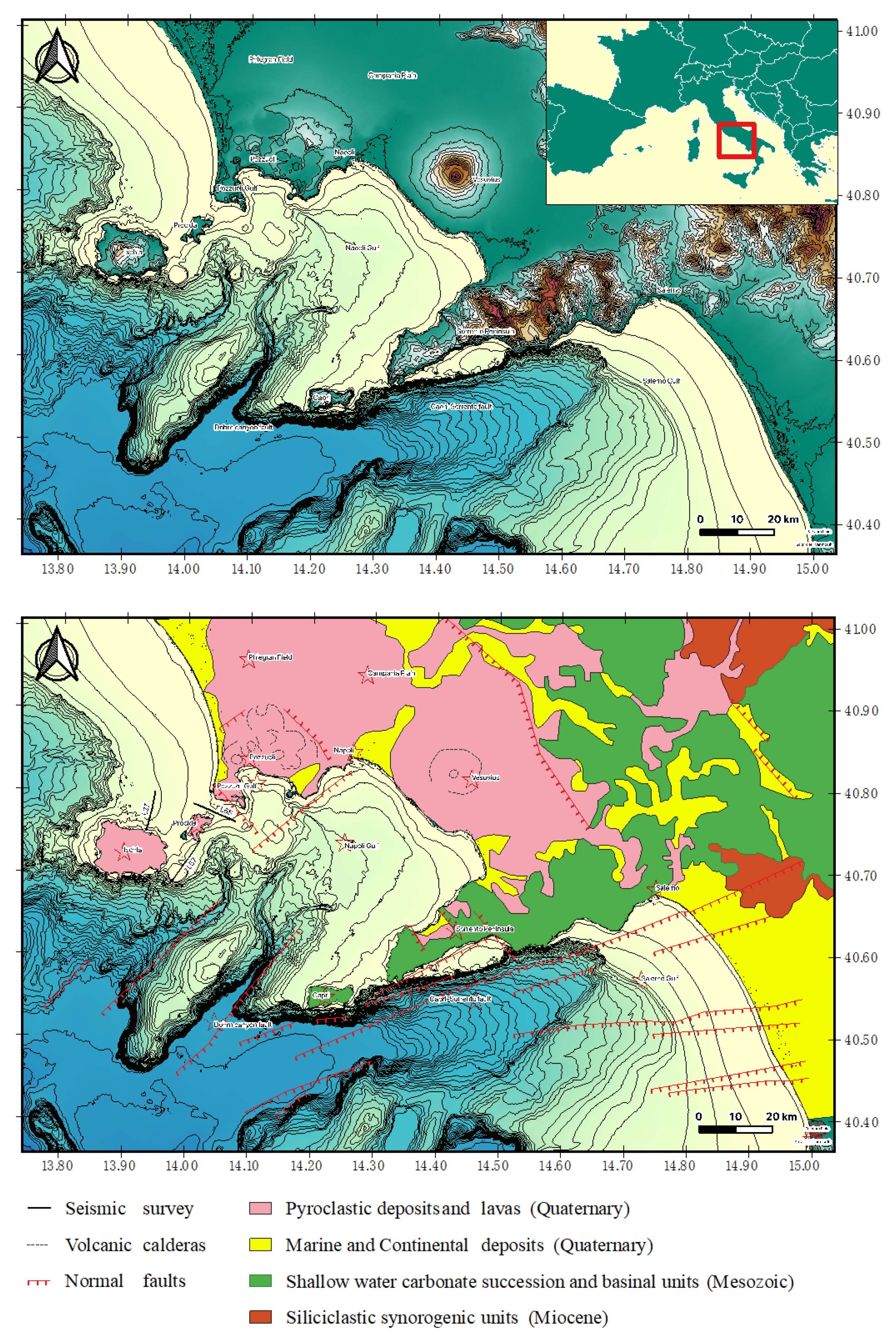
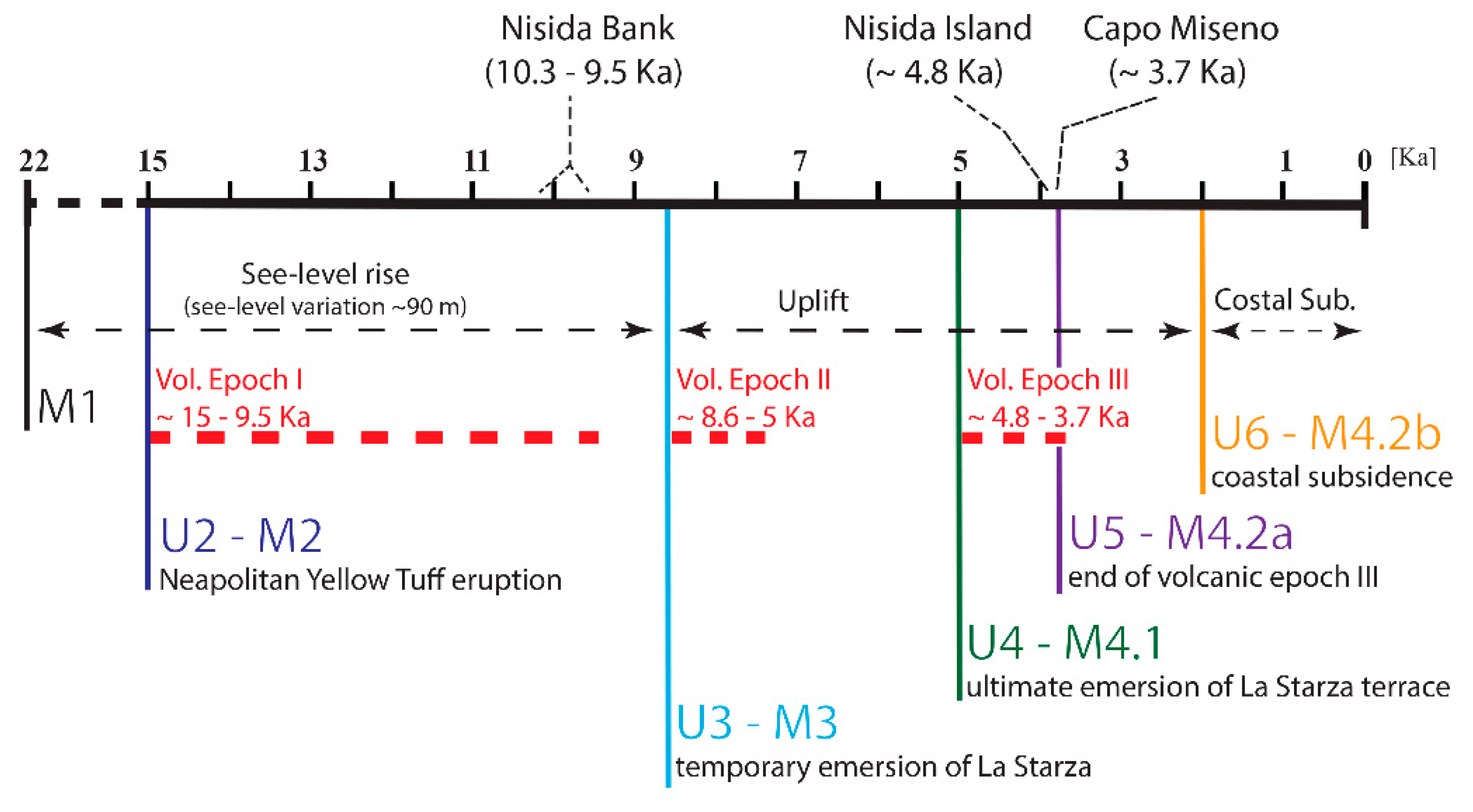
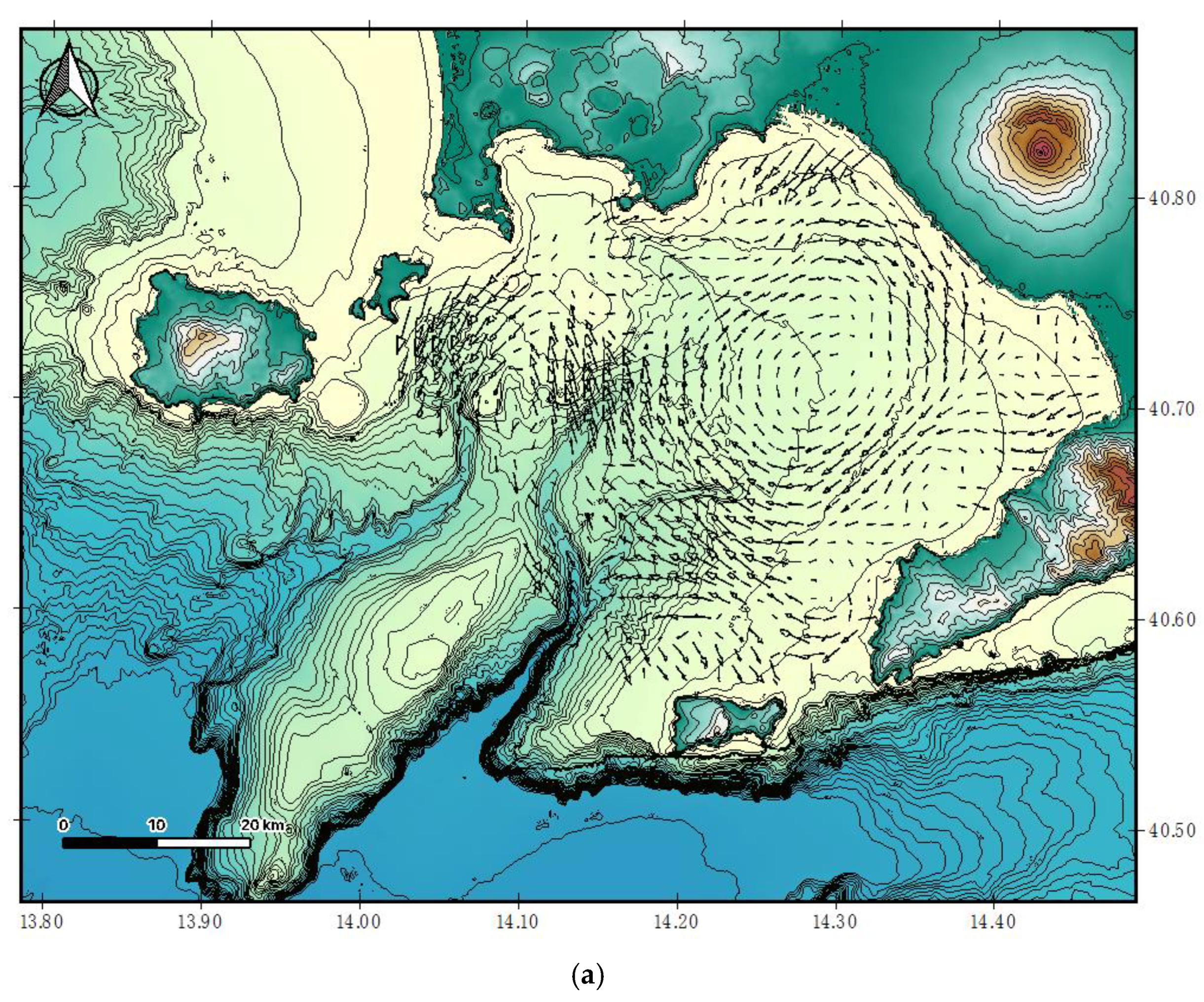


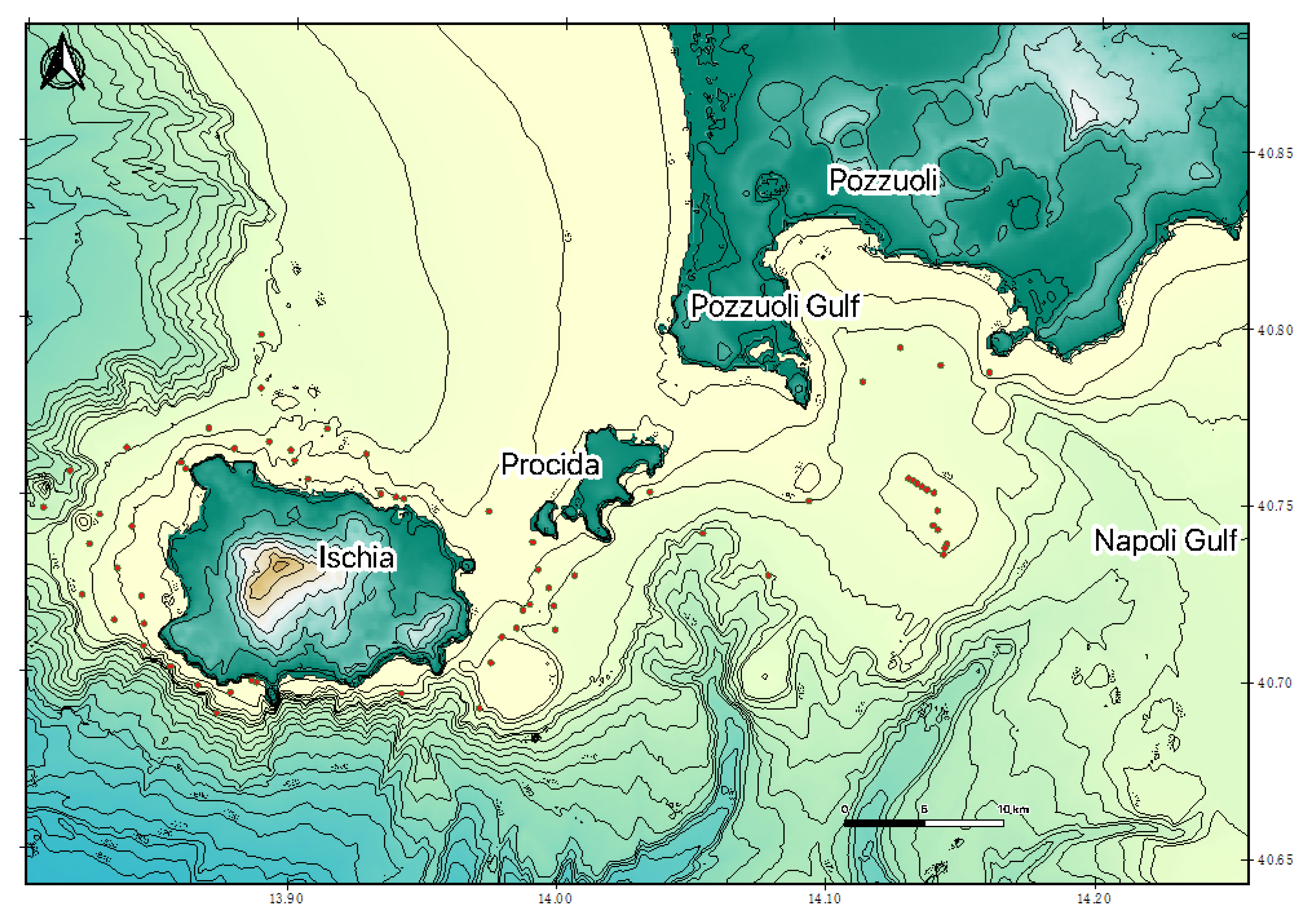
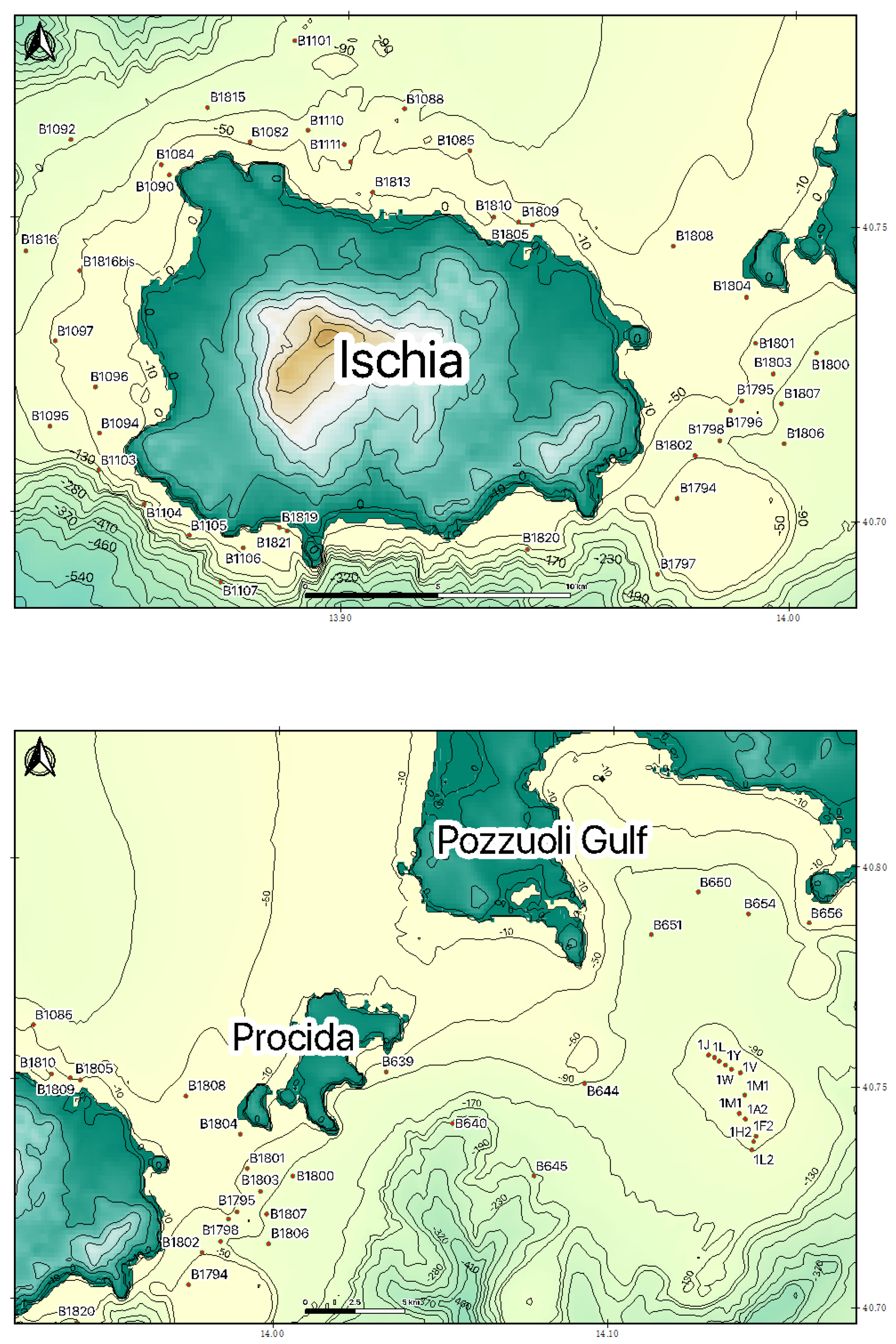
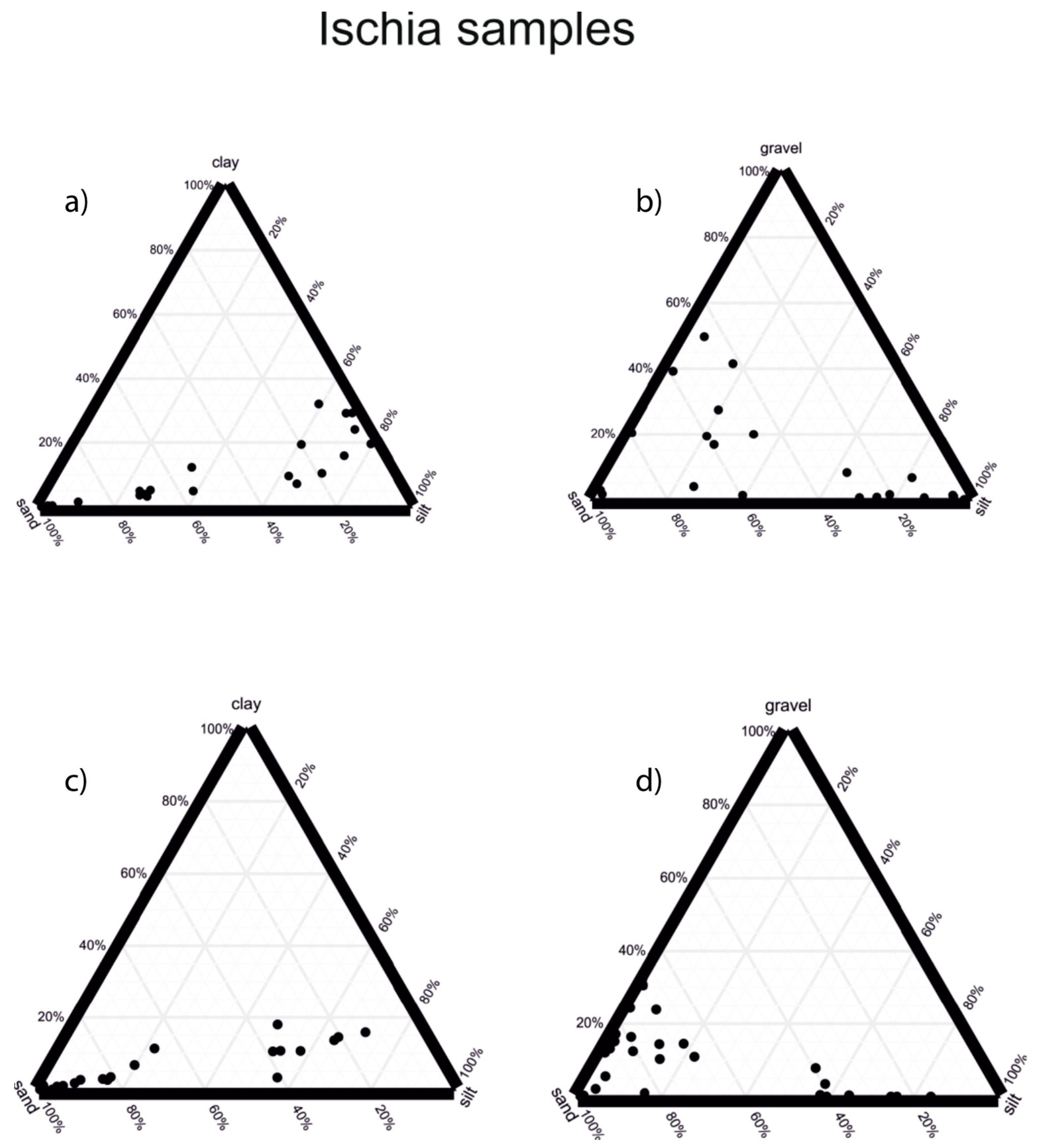
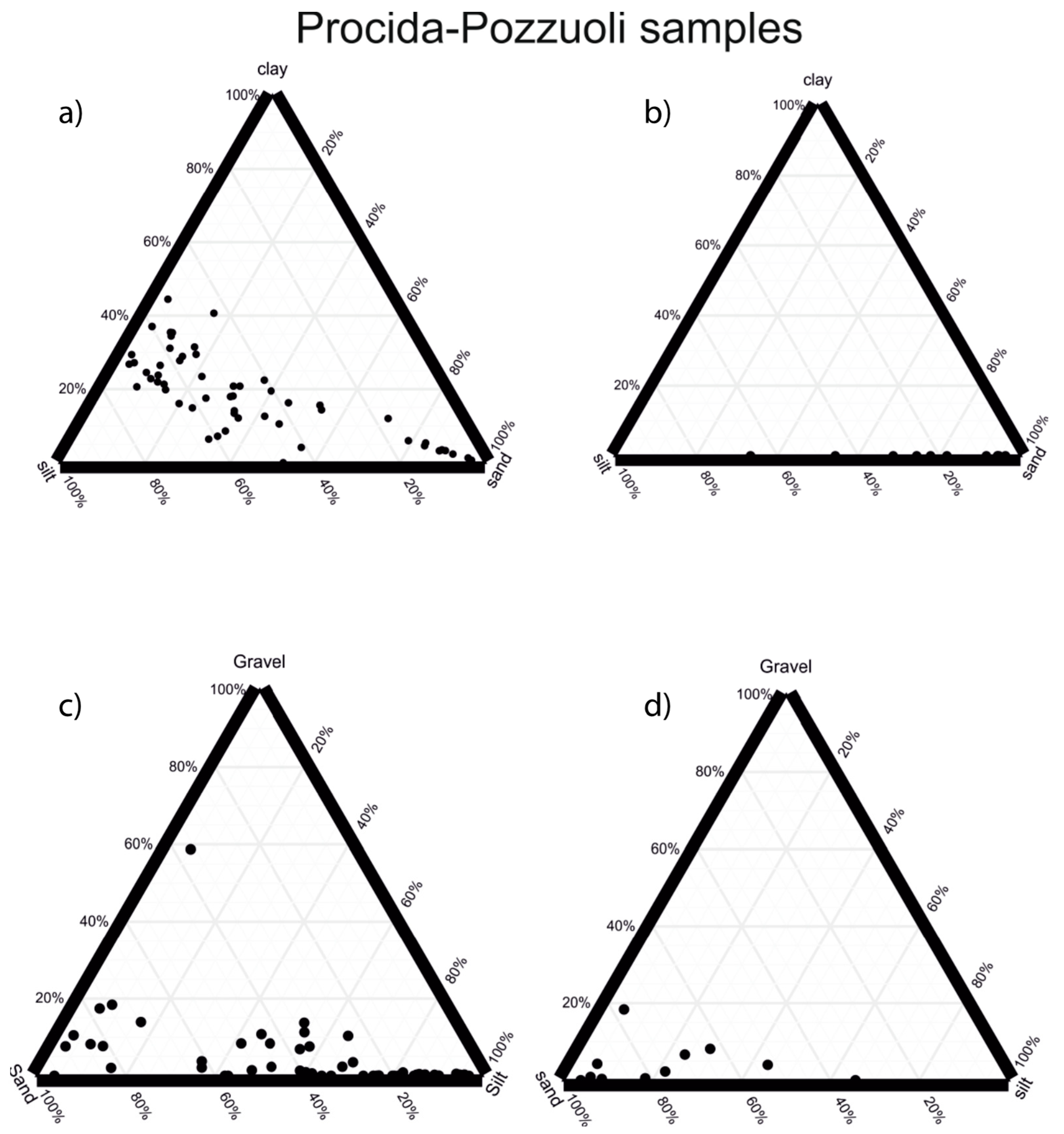
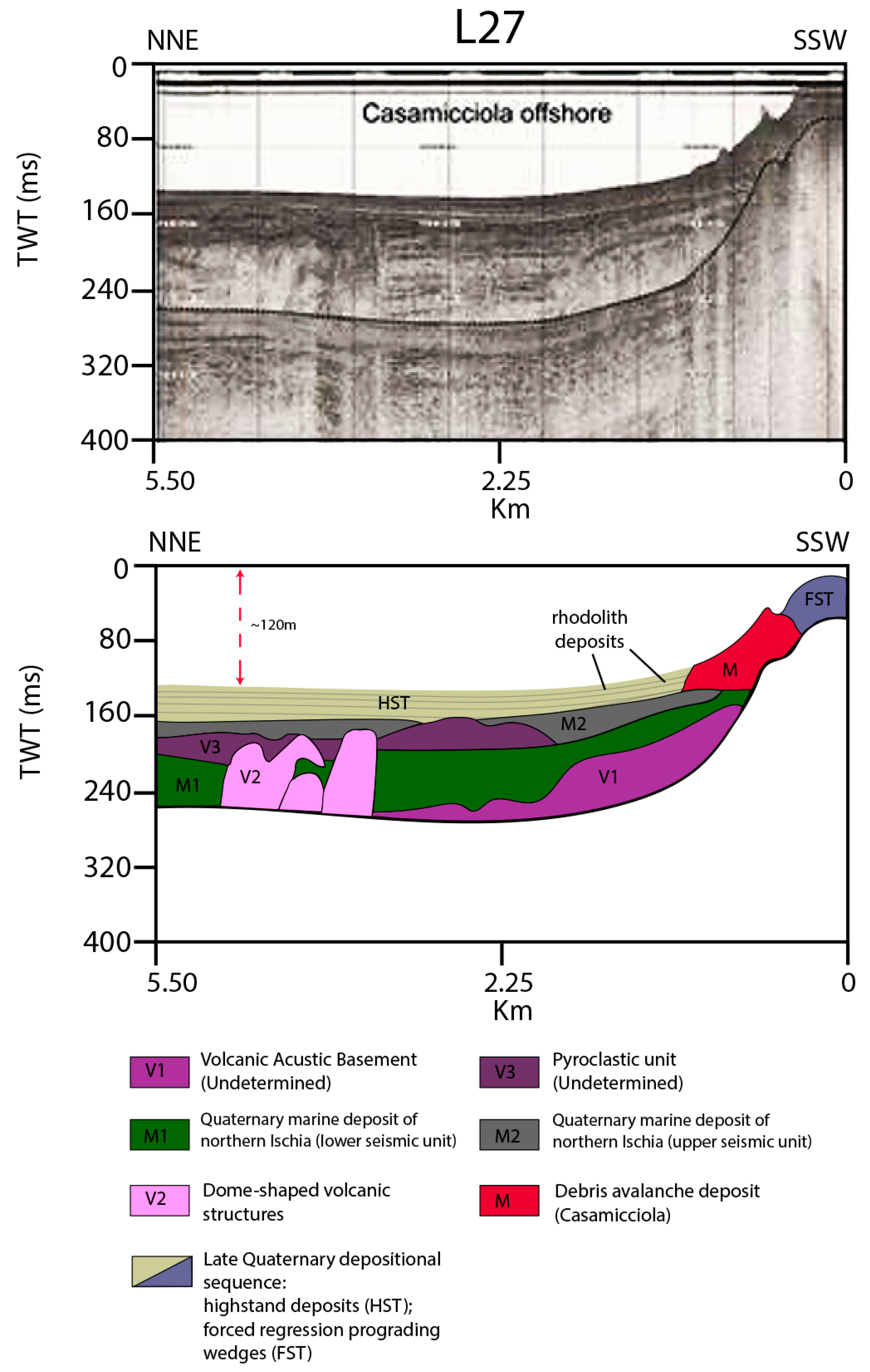
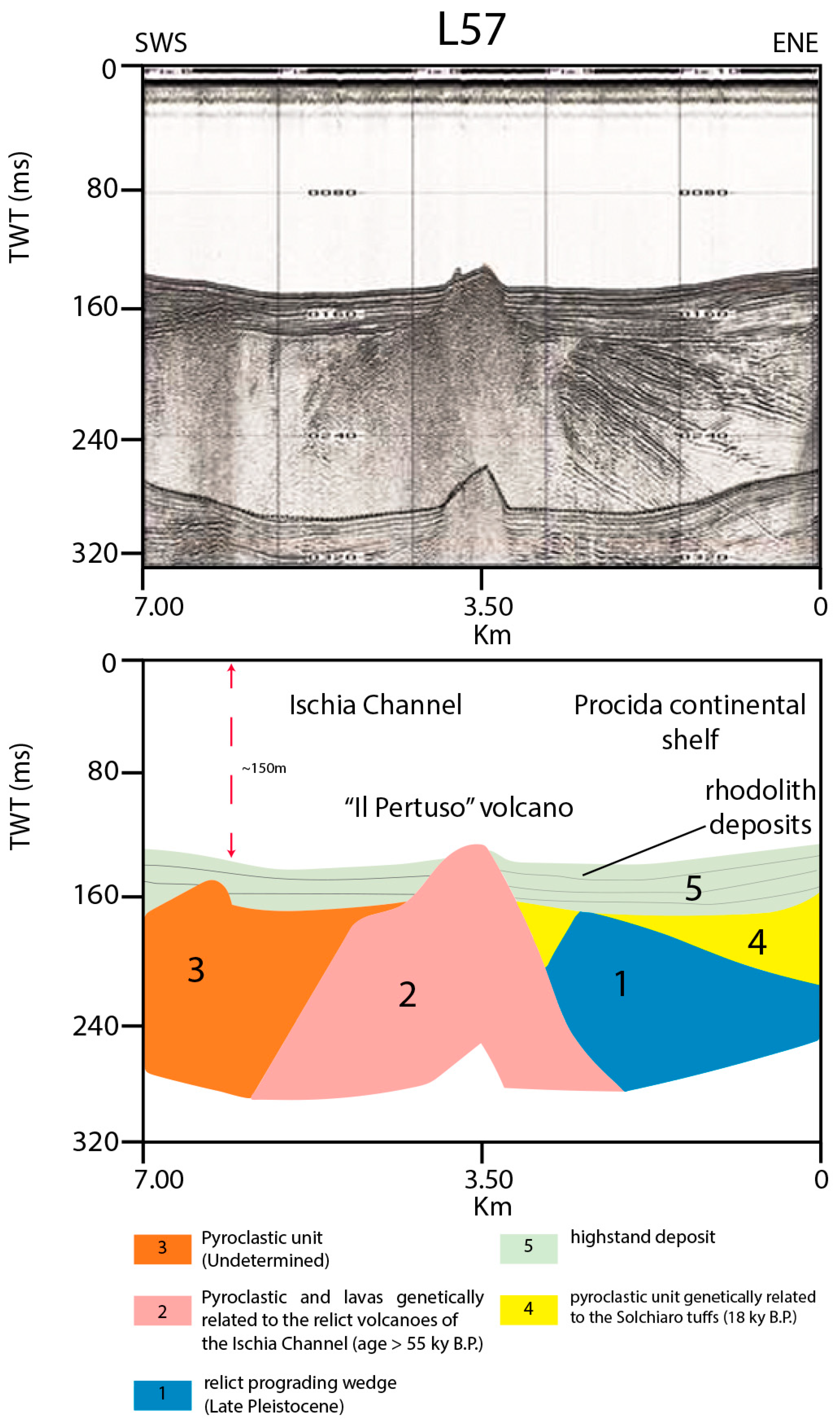
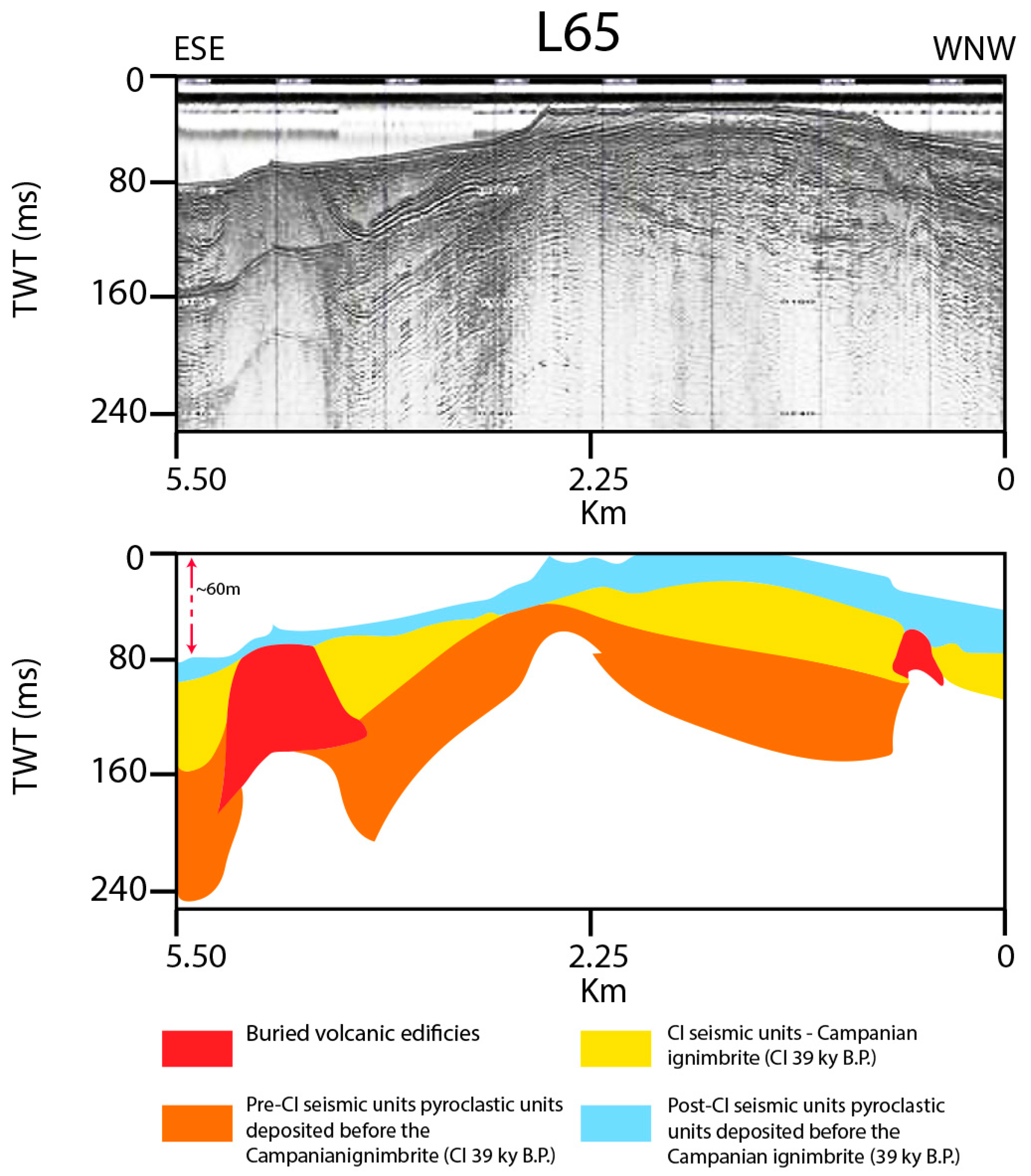
Publisher’s Note: MDPI stays neutral with regard to jurisdictional claims in published maps and institutional affiliations. |
© 2021 by the authors. Licensee MDPI, Basel, Switzerland. This article is an open access article distributed under the terms and conditions of the Creative Commons Attribution (CC BY) license (https://creativecommons.org/licenses/by/4.0/).
Share and Cite
Aiello, G.; Caccavale, M. From Siliciclastic to Bioclastic Deposits in the Gulf of Naples: New Highlights from Offshore Ischia and Procida–Pozzuoli Based on Sedimentological and Seismo-Stratigraphic Data. Quaternary 2021, 4, 44. https://doi.org/10.3390/quat4040044
Aiello G, Caccavale M. From Siliciclastic to Bioclastic Deposits in the Gulf of Naples: New Highlights from Offshore Ischia and Procida–Pozzuoli Based on Sedimentological and Seismo-Stratigraphic Data. Quaternary. 2021; 4(4):44. https://doi.org/10.3390/quat4040044
Chicago/Turabian StyleAiello, Gemma, and Mauro Caccavale. 2021. "From Siliciclastic to Bioclastic Deposits in the Gulf of Naples: New Highlights from Offshore Ischia and Procida–Pozzuoli Based on Sedimentological and Seismo-Stratigraphic Data" Quaternary 4, no. 4: 44. https://doi.org/10.3390/quat4040044




